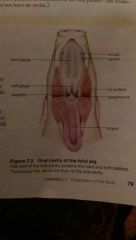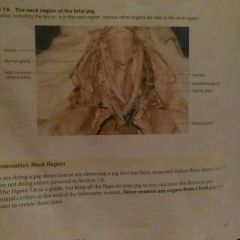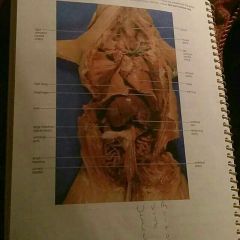![]()
![]()
![]()
Use LEFT and RIGHT arrow keys to navigate between flashcards;
Use UP and DOWN arrow keys to flip the card;
H to show hint;
A reads text to speech;
40 Cards in this Set
- Front
- Back
|
Dorsal
|
toward the back
|
|
|
ventral
|
toward the front
|
|
|
anterior
|
toward the head
|
|
|
posterior
|
toward the rear
|
|
|
kidneys
|
produce urine
|
|
|
urinary bladder
|
stores urine
|
|
|
urethra
|
urethra conducts urine out of the body
|
|
|
nasal passages
|
in the nose
|
|
|
nasopharynx
|
takes air into the pharynx
|
|
|
pharynx
|
back of throat
|
|
|
glottis
|
opening to the trachea, back of epiglottis
|
|
|
larynx
|
voice box ,top part of trachea
|
|
|
trachea
|
conducts air to bronchi
|
|
|
bronchi
|
conducts air to the lungs
|
|
|
esophagus
|
conducts food to the stomach
|
|
|
stomach
|
stores food, some digestion
|
|
|
small intestine
|
digest food to small molecules that are absorbed into the body
|
|
|
large intestine
|
absorbs water, stores undigested remains until feces are expelled from the anus
|
|
|
heart
|
part of the cardiovascular system, contains blood vessels
|
|
|
thyroid gland
|
produces hormone thyroxin
|
|
|
pancreas
|
produces hormone insulin and glucagon
|
|
|
thyroid gland and pancreas
|
are part of the endocrine system
|
|
|
thymus gland, spleen and appendix
|
part of the lymphatic system b/c they contain lymphatic tissue
|
|
|
spleen
|
purifies blood
|
|

oral cavity
|
the roof of the oral cavity contains the hard and soft palates. the tongue lies above the floor of the oral cavity
|
|

the neck region
|
the trachea including the larynx is in the neck region along with other organs
|
|

internal anatomy of the fetal pig
|
organs inside of pig
|
|
|
peritoneum
|
the abdominal wall and organs lined by connective tissue membrane
|
|
|
mesenteried
|
double layered sheets of peritoneum
|
|
|
digestive system
|
stomach,small intestine and large intestine
|
|
|
stomach
|
stores food and has numerous gastric glands that secrete gastric juice which digest protien
|
|
|
small intestine
|
receives secretions from the pancreas and gallbladder
|
|
|
duodenum
|
the first part of the small intestine
|
|
|
large intestine
|
absorbs water and prepares feces for defecation at the anus
|
|
|
colon
|
main part of the large intestine
|
|
|
rectum
|
the last portion of the large intestine. the rectum leads to the anus
|
|
|
liver
|
the largest organ In the abdomen. disposes worn out red blood cells,produces bile,stores glycogen,maintains blood glucose level,and produces blood proteins.
|
|
|
gallbladder
|
stores and releases bile which aids the digestion of fat.
|
|
|
bile
|
an emulsifier that breaks of fat into smaller fat droplets for better access by digestive enzymes
|
|
|
pancreas
|
both an exocrine and endocrine gland. as a exocrine it produces and secretes pancreatic juice which digest all the components of food in the small intestine.as an endocrine gland the pancreas secretes the hormones insulin and glucagon into the bloodstream
|

